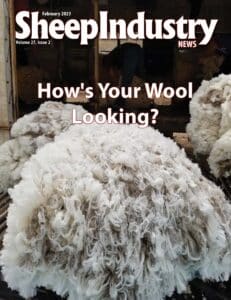A light snow begins to fall on a November Sunday afternoon in Central New York state as John Lemondes heads to the pasture where he’ll round up the final 20 head of lambs to fulfill his 2022 slaughter commitments.
Most of the family is involved in the process. In the pasture, John grabs a feed bucket and leads the way. A pair of energetic guard dogs fall in behind as he heads for a holding pen in the corner of a neighboring pasture. The sheep – encouraged by the guidance of John’s son, 13-year-old JJ, on a dirt bike – fall into line. John’s wife, Martha, brings up the rear in a utility vehicle pulling a small trailer that will corral eight to 10 sheep at a time.
The pastures are too soft from recent rain and snow to simply drive the truck and stock trailer to the holding pen. Instead, the family will shuttle the selected sheep back to the main barn in three separate loads. It’s not the efficient use of time one might expect from a retired Army colonel, but it’s a common scenario that plays out daily on family farms all across the United States.
Farming has long been a dream for John, and there’s no one he’d rather do it with than his family, which also includes 17-year-old daughter Olivia. The farm – Elly’s Acres – is named in honor of the couple’s other daughter, who passed away in 2016 approximately two years after the family had settled on a 500-acre place in Jamesville, N.Y., some 15 miles from where John spent his childhood.
It was here in Onondaga County, where he developed a passion for all things outdoors: hunting, fishing, trapping, and yes, even farming.
“My first paid job was as a fruit picker on a farm,” he recalls. “It was the summer before I started sixth grade. One day, my father told me to get in the car and we were going to get me a job. He took me to the farm, and I remember him talking to the farmer, who said, ‘He looks kind of small.’ My dad said, ‘Yeah, but he’ll work.’”
And work he did, that whole summer. He couldn’t keep up with the adults he was alongside, but he never quit. He continued to work on farms through his high school years, eventually making his way to a livestock operation.
“My bachelor’s degree from Penn State is in agricultural science. I have always wanted to own a farm of some type,” he says. “I just didn’t know exactly what it was or where it was going to be.”
It Had To Be Wool
It should come as no surprise that he found his way to wool sheep. After all, John still owns (and wears) a pair of Woolrich wool pants he first got as a teenager.
“They’re in that typical red and black pattern,” he says. “My kids mock me because they know I’ve had them since I was 14 or 15 years old, but they’re still going strong. They’re my main pair of ice fishing/hunting pants. I’ve been a wool user my entire life.”
Even the U.S. Army indulged John’s passion for agriculture when it assigned him to the agriculture committee while he was a student at the Army War College. He studied agriculture and its importance not only in the United States, but in India, Thailand and Vietnam. He worked on textile projects in the final years of his time with the Army, as well. After retiring, John spent a year working as a military consultant for clients that included ASI.
“That all kind of layered itself together and was really helpful in solidifying my desire to be a farmer,” he says. “Sheep are the most efficient ruminants there are. And even though we generally have good pastures in this area, choosing sheep made it easier when it was time to decide which farm property to purchase. I didn’t have to worry about finding one with the best possible soil profile, which would be more important for growing crops. That removed a huge issue for us.”
Of Greek and Irish decent, John grew up eating lamb on a regular basis, despite the fact that there was no room to raise animals of their own in the family’s suburban home.
“But it was a small suburb, and we were surrounded by farms,” John adds. “As a kid, I could just walk across the street to farm fields and woods and hunt and trap. I don’t know what kids do after school now, but I was always out hunting, fishing and trapping, and I loved it.”
Purchasing the land for Elly’s Acres was just the start of John’s farming adventure. A horse farm in its past life, the place had been severely neglected by its most recent owners. The house needed a bit of everything, including a new roof.
“It was like camping inside those first few months,” John says. “It rained on us in the house that summer. It was so overgrown around the house that we could barely get into it. We started the process of rebuilding it from the frame out.”
The rest of the property was in similar condition. Nothing drained properly. Previous owners had stuck railroad ties into the ground as fence posts. A fire pit was setup two feet from a wooden barn.
“The goal was to have livestock on the ground within a year of taking possession,” John says. “We physically occupied the house in November 2013 and had livestock on the ground in September 2014. That was really important to us.”
The family started with 20 breeding ewes and one ram. Eight years later, the ewe flock is up to nearly 160. John would like to expand the breeding flock to 700 or more, but he’s intentionally taking a slow roll approach that allows him to maintain financial control of the farm.
“The banks don’t own us, and that’s a conscious decision on our part,” he says. “It’s why my wife and I both have off-farm jobs, as well. People don’t realize how hard it was those first six years. We were going through all of the problems that come with starting a new farm, raising kids, working jobs. It was hard, but it gave us a lot of control over our operation.”
Daily Challenges
Two hours after the process of sorting lambs started, the sheep are loaded and ready for the two-hour drive to the nearest slaughter facility. John skipped lunch, of course, and dinner will have to wait until he’s back from dropping off the sheep. There’s more snow on the way and the drive to the slaughter facility requires a trek through one of the snowiest areas in the entire country, which means John is anxious to get there and back as quickly as possible.
Since he spends his days working as the District 126 representative to the New York State Assembly – he was re-elected in November 2022 – John is thankful for a facility that allows him to deliver sheep outside of regular business hours. But he also laments the loss of such facilities throughout the state, a fact that has often left him scrambling to find available spots for slaughter.
“We’re doing this in the most inefficient way we can as we struggle to find slaughter availability. We end up taking some lambs that are smaller than we’d like because we have to make our appointments a year in advance,” he says. “This year, my first appointment is in August, which isn’t great, but we have to take it.”
Once his lamb is processed, John sells through a handful of avenues. He’s built a loyal following at two farmers markets while also selling meat directly off the farm. He offers on-farm kill for a handful of ethnic customers who request it. It adds up to roughly 100 lambs a year, a number he plans to increase through managed growth.
“The goofy slaughter schedule impacts our ability to do a lot of the things we’d like to do,” he said. “We just have to manage it like we do everything else on the farm.”
The wool is no different. In the farm’s early years, John sent most of it to the area wool pool. But the recent trade war with China interrupted that market and left John and Martha looking for other options. They’ve worked with several domestic mills to develop a wool clothing line that so far has sold under the Elly’s Acres name.
“This whole region was once really strong in sheep and wool and the infrastructure needed to sustain it,” John says. “But then it just vanished. There used to be a lot of meat packing here, a lot of mills here. But as the country transitioned from local and regional to regional and national, it all went away.”
While John is somewhat guarded about the breeding of his flock, he says his focus is to breed for fine wool and good meat. “I don’t have the super finest 14-micron wool, but our wool is really good,” he says. “The other piece is that our operation is grass-fed, pasture-raised. That causes them to grow a little slower, but people love it. There’s a different taste profile, and it makes a difference our customers can taste.”
Additional Opportunities
The farm is located in the heart of maple country, and John hopes to start tapping trees in the coming year. It’s a revenue source he’s planned on since buying the property, but chose to pursue building the sheep flock first. He’s working through the process to bring in H-2A help to work with both the sheep and the syrup, and even purchased a home across the road from his as a place for farm labor to live in the future.
A cabin on the farm had also fallen into disrepair. It took five years, but John and Martha eventually refurbished the home and regularly rent it through Airbnb to people traveling to nearby Syracuse, N.Y.
“There’s no TV, and that’s by design,” John says. “It does have wifi, but we wanted it to be a place where people could rest and enjoy nature. We do farm tours for the people who rent it, and for farm income diversification it was a key investment for us.
“We’ve done the ‘easy’ upgrades on the property. Now, we’re starting to look at some bigger additions. The next barn is going to be a huge project. We might build a second Airbnb. There’s a lot that we can still do with the property that we have.”
The one thing he doesn’t want to do is build a farm that is one day a burden to his children. “They both started working on the farm at a young age, and have been instrumental in its operation from an early age. But it isn’t my goal or mandate in life that they take over this farm one day,” John says. “I wouldn’t be surprised if one or both decides to do something with it. But I don’t want to saddle them with something that can’t be successful.”



